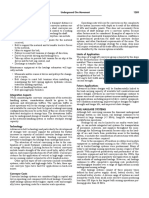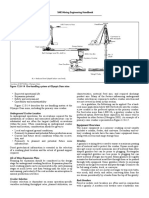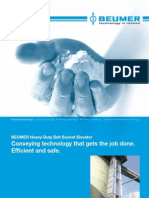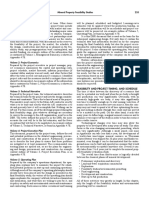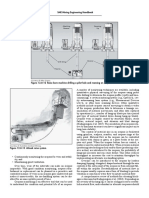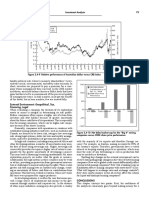Conveyors: 1288 Sme Mining Engineering Handbook
Conveyors: 1288 Sme Mining Engineering Handbook
Uploaded by
YeimsCopyright:
Available Formats
Conveyors: 1288 Sme Mining Engineering Handbook
Conveyors: 1288 Sme Mining Engineering Handbook
Uploaded by
YeimsOriginal Title
Copyright
Available Formats
Share this document
Did you find this document useful?
Is this content inappropriate?
Copyright:
Available Formats
Conveyors: 1288 Sme Mining Engineering Handbook
Conveyors: 1288 Sme Mining Engineering Handbook
Uploaded by
YeimsCopyright:
Available Formats
1288 SMe Mining engineering handbook
when uncrushable objects enter the crushing chamber. Foreign
objects, such as steel, can cause extensive damage to a cone
crusher and additional costs in lost production. Advancement
in hydraulic relief systems has greatly reduced downtime and
improved the life of these machines.
ConveyoRS
Mine conveyor systems have been utilized in underground
mass mining for many years. Conveyor systems are com-
monly found in underground continuous coal mining opera-
tions, which use longwall and room-and-pillar methods. More
recently, underground conveyor systems have been employed
in large-scale, long-life metalliferous mines. Conveyors are
more commonly used in operations where mine geometry and
production flow allow conveyor haulage to be more efficient
or cost-effective than other methods.
Inclined, troughed belt conveyors are more frequently
being selected from a range of alternatives, which include
shafts and trucks, for ore haulage in underground mass min-
ing projects. Belt conveyor haulage systems are being oper-
ated with lifts exceeding those normally associated with truck
haulage systems and approaching the limits of shaft haulage
systems (Spreadborough and Pratt 2008).
Continued development of conveyor technology has
resulted in increased confidence in and reliability of these
systems. Reliability of conveyor-based haulage systems as a
whole is impacted by the complexity of larger configurations
constructed of multiple units or lifts. Modern conveyor instal-
lations have proven high availabilities (>85% are achievable
in underground operations), which has added confidence to
their use in recent times.
Figure 12.8-16 shows a typical conveyor in an under-
ground metalliferous mine operation.
Safety Considerations
Courtesy of BHP Billiton Olympic Dam.
In the selection of conveying options for an underground oper-
figure 12.8-16 Typical conveyor in an underground metal-
ation, several risk areas must be addressed, including
liferous mine operation
• Belt fires managed by self-extinguishing belt covers and
auto detection and suppression systems;
• Belt failures addressed by belt-rip detection systems, • Reliability/availability;
monthly belt scans, and concrete bulkheads; • Operating life;
• Guarding requirements to prevent injury to personnel; • Size of product handled, spillage, and carry-back;
• Audible start-up alarms where personnel work near the • Dust and noise generation; and
belt; • Automatic, remote operations.
• Emergency stop provisions in areas where access by per-
The advantages of conveying material include high auto-
sonnel is required; and
mation, minimal operational labor requirements and lower
• Dust management.
operating costs, and high reliability/availability.
The disadvantages of conveying material include high
Selection Criteria
capital cost (therefore lower probability of duplication), a
The selection of haulage systems for underground mass min-
large footprint, and limited flexibility.
ing has historically focused on shaft haulage, trucks, and
Belt conveyors for underground service usually have a
belt conveyors. The application of these alternatives in the
more rugged design and operate at slower speeds than a com-
Australian mining industry is summarized in Figure 12.8-3.
parable overland conveyor. Hard-rock mine belt conveyors
Troughed belt conveyors are shown in this figure to be applied
normally require the ore to be crushed before it is conveyed
in the range up to 8 Mt/a production rate and 1,200-m lift.
or at least sized through a grizzly. Reasons for this include
Selection criteria for underground conveyor haulage include
increased belt life due to reduced impact from lumps and
• Inherent safety; elimination of tramp material, including rock bolts, rebar, drill
• Capacity (steady state and surge flow); steels, and scaling bars, which can seriously affect the integ-
• Simplicity in design and operation; rity of the belt system.
• Dimensions (length, height, and width); Belt conveyor systems are less flexible than truck haul-
• Maneuverability/adaptability to various layouts; age and require a high initial investment. This generally
• Cost (capital and operating); means that belt conveyors are the economical choice when the
You might also like
- Bulk Material Handling: Practical Guidance for Mechanical EngineersFrom EverandBulk Material Handling: Practical Guidance for Mechanical Engineers5/5 (1)
- Cost Analysis of Material Handling Systems in Open Pit MiningNo ratings yetCost Analysis of Material Handling Systems in Open Pit Mining19 pages
- Coiled Tubing Operations at a Glance: What Do You Know About Coiled Tubing Operations!From EverandCoiled Tubing Operations at a Glance: What Do You Know About Coiled Tubing Operations!5/5 (2)
- Cost Considerations Safety Considerations: Underground Ore Movement 1285No ratings yetCost Considerations Safety Considerations: Underground Ore Movement 12851 page
- Limits of Application: Underground Ore Movement 1289No ratings yetLimits of Application: Underground Ore Movement 12891 page
- CHAPTER 10.3_Mechanical Extraction, Loading, And HaulingNo ratings yetCHAPTER 10.3_Mechanical Extraction, Loading, And Hauling27 pages
- Inclined Belt Conveyors For Underground Mass Mining OperationsNo ratings yetInclined Belt Conveyors For Underground Mass Mining Operations6 pages
- An Update On In-Pit Crushing-Conveying-Stacking Systems in Surface Metal Mines0% (1)An Update On In-Pit Crushing-Conveying-Stacking Systems in Surface Metal Mines11 pages
- Application of Conveyors For UG HaulageNo ratings yetApplication of Conveyors For UG Haulage11 pages
- LoadingToolSelectionGuide Brochure English EN-LTSGBR01-0522-V3100% (1)LoadingToolSelectionGuide Brochure English EN-LTSGBR01-0522-V336 pages
- Design Optimization For Modification of Trough Belt Conveyor To Reduce Material Spillage Used in Clinker Transport in Cement PlantNo ratings yetDesign Optimization For Modification of Trough Belt Conveyor To Reduce Material Spillage Used in Clinker Transport in Cement Plant11 pages
- Worlds Longest Single Flight Conventional Overland Belt ConveyorNo ratings yetWorlds Longest Single Flight Conventional Overland Belt Conveyor10 pages
- Improvement in Operational Efficiency Parameters 22.12.24No ratings yetImprovement in Operational Efficiency Parameters 22.12.2436 pages
- Presentación de Actividades Realizadas Durante Prácticas Pre ProfesionalesNo ratings yetPresentación de Actividades Realizadas Durante Prácticas Pre Profesionales28 pages
- Design and Optimization of Roller in Belt Conveyor System For Weight ReductionNo ratings yetDesign and Optimization of Roller in Belt Conveyor System For Weight Reduction4 pages
- Underground Ore Movement 1287: Integration AspectsNo ratings yetUnderground Ore Movement 1287: Integration Aspects1 page
- 3.conveyor Belt Selection-Design For High Speed ConveyorsNo ratings yet3.conveyor Belt Selection-Design For High Speed Conveyors17 pages
- 9 Engineering of Mechanical System and Equipment100% (1)9 Engineering of Mechanical System and Equipment38 pages
- 1286 Sme Mining Engineering Handbook: Figure 12.8-14 Ore-Handling System at Olympic Dam MineNo ratings yet1286 Sme Mining Engineering Handbook: Figure 12.8-14 Ore-Handling System at Olympic Dam Mine1 page
- 6 Module 6 Construction Equipment Operations and MaintenanceNo ratings yet6 Module 6 Construction Equipment Operations and Maintenance9 pages
- A Remotely Operated Robotic Rock-Breaker With Collision Avoidance For The Mining IndustryNo ratings yetA Remotely Operated Robotic Rock-Breaker With Collision Avoidance For The Mining Industry6 pages
- Department of Petroleum and Mining Engineering, Chittagong University of Engineering and Technology, BangladeshNo ratings yetDepartment of Petroleum and Mining Engineering, Chittagong University of Engineering and Technology, Bangladesh1 page
- Conveyor_belt_1_of_2_17377218651234492576679388092f03fNo ratings yetConveyor_belt_1_of_2_17377218651234492576679388092f03f94 pages
- Modelling of In-Pit Crusher Conveyor AlternativesNo ratings yetModelling of In-Pit Crusher Conveyor Alternatives8 pages
- Conveyor Belt Selection/Design For High Speed ConveyorsNo ratings yetConveyor Belt Selection/Design For High Speed Conveyors11 pages
- All About Tunnel Boring Machine (TBM) & Parameters - CivilDigitalNo ratings yetAll About Tunnel Boring Machine (TBM) & Parameters - CivilDigital11 pages
- A_Letter_on_Belt_Conveyor_System_as_a_Mode_of_TranNo ratings yetA_Letter_on_Belt_Conveyor_System_as_a_Mode_of_Tran5 pages
- Selection of A Right Conveyor and A FeederNo ratings yetSelection of A Right Conveyor and A Feeder46 pages
- Continuous Mining Systems: Industrial SolutionsNo ratings yetContinuous Mining Systems: Industrial Solutions3 pages
- Mineral Property Feasibility Studies 235: Volume 2: Project EconomicsNo ratings yetMineral Property Feasibility Studies 235: Volume 2: Project Economics1 page
- Block Caving 1443: Figure 13.10-7 Extraction Level Under Construction Using An Advanced Undercut, Doz Mine, IndonesiaNo ratings yetBlock Caving 1443: Figure 13.10-7 Extraction Level Under Construction Using An Advanced Undercut, Doz Mine, Indonesia1 page
- 260 Sme Mining Engineering Handbook: Volume 5: Operating PlanNo ratings yet260 Sme Mining Engineering Handbook: Volume 5: Operating Plan1 page
- A Global Perspective On Mining Legislation: Diana DaltonNo ratings yetA Global Perspective On Mining Legislation: Diana Dalton1 page
- Heavy Mineral Separations: Geochemical Prospecting 133No ratings yetHeavy Mineral Separations: Geochemical Prospecting 1331 page
- References: 126 Sme Mining Engineering HandbookNo ratings yetReferences: 126 Sme Mining Engineering Handbook1 page
- Geologic Interpretation, Modeling, and Representation 179No ratings yetGeologic Interpretation, Modeling, and Representation 1791 page
- 1376 Sme Mining Engineering Handbook: Advantages and DisadvantagesNo ratings yet1376 Sme Mining Engineering Handbook: Advantages and Disadvantages1 page
- 1284 Sme Mining Engineering Handbook: Drilling Pilot Hole Down Attaching Reamer Reaming UpNo ratings yet1284 Sme Mining Engineering Handbook: Drilling Pilot Hole Down Attaching Reamer Reaming Up1 page
- Health and Medical Issues in Global Mining 1575No ratings yetHealth and Medical Issues in Global Mining 15751 page
- 108 Sme Mining Engineering Handbook: Geochemical Analytical MethodsNo ratings yet108 Sme Mining Engineering Handbook: Geochemical Analytical Methods1 page
- 104 Sme Mining Engineering Handbook: Type 10No ratings yet104 Sme Mining Engineering Handbook: Type 101 page
- 148 Sme Mining Engineering Handbook: SymbolsNo ratings yet148 Sme Mining Engineering Handbook: Symbols1 page
- 70 Sme Mining Engineering Handbook: Cost of CapitalNo ratings yet70 Sme Mining Engineering Handbook: Cost of Capital1 page
- Sub-Subtype 9.2.2.1: Algoma Bif: Geological Features and Genetic Models of Mineral Deposits 97No ratings yetSub-Subtype 9.2.2.1: Algoma Bif: Geological Features and Genetic Models of Mineral Deposits 971 page
- Valuation of Producing Mining Companies: Internal Factors Affecting Cash FlowsNo ratings yetValuation of Producing Mining Companies: Internal Factors Affecting Cash Flows1 page
- 84 Sme Mining Engineering Handbook: Destructive Plate MarginsNo ratings yet84 Sme Mining Engineering Handbook: Destructive Plate Margins1 page
- Investment Analysis 79: Figure 2.4-9 Relative Performance of Australian Dollar Versus CRB IndexNo ratings yetInvestment Analysis 79: Figure 2.4-9 Relative Performance of Australian Dollar Versus CRB Index1 page
- Acknowledgments: 80 Sme Mining Engineering HandbookNo ratings yetAcknowledgments: 80 Sme Mining Engineering Handbook1 page
- 86 Sme Mining Engineering Handbook: Surface or Seafloor HydrothermalNo ratings yet86 Sme Mining Engineering Handbook: Surface or Seafloor Hydrothermal1 page
- Valuation of Producing Mining Companies: External Factors Affecting Cash FlowsNo ratings yetValuation of Producing Mining Companies: External Factors Affecting Cash Flows1 page
- Argus Coalindo Indonesian Coal Index ReportNo ratings yetArgus Coalindo Indonesian Coal Index Report2 pages
- PT - PN.03.24.0015 - Fornecimento de Energia Elétrica em Tensão Secundária - Edificações Coletivas PDFNo ratings yetPT - PN.03.24.0015 - Fornecimento de Energia Elétrica em Tensão Secundária - Edificações Coletivas PDF193 pages
- Ac 25kv 50 HZ Electrification Supply Design White2013No ratings yetAc 25kv 50 HZ Electrification Supply Design White201343 pages
- 12.ORDIN NR 12 2015 Regulament Licente EE EngNo ratings yet12.ORDIN NR 12 2015 Regulament Licente EE Eng16 pages
- Integrating Sustainable Development, Lean, and Logistics Concepts Into A Lean Sustainable Logistics ModelNo ratings yetIntegrating Sustainable Development, Lean, and Logistics Concepts Into A Lean Sustainable Logistics Model20 pages
- Cylindrical Roller Bearing-TB Optimised Rib ContactNo ratings yetCylindrical Roller Bearing-TB Optimised Rib Contact6 pages
- Safvolt Switchgears Private Limited - ProductsNo ratings yetSafvolt Switchgears Private Limited - Products24 pages
- Maxpro200: Longlife Air and Oxygen Plasma Cutting SystemNo ratings yetMaxpro200: Longlife Air and Oxygen Plasma Cutting System4 pages










